|
Two
suspected killers in custody Friday, 30th November, 2012 Yesterday, the news broke that two people have been arrested and are being held pending
trial for the poisoning to death of 22 Oriental White Storks and dozens of other birds at Beidagang Wetland,
near Tianjin. Today, at 10.04am Beijing
time [2.04am GMT], the People's Daily Online published an article about this. A translation appears here: The case of
the “11/11” poisoning to death of Oriental White Storks at Beidagang Wetland, Tianjin municipality, has been cracked.  According to a report from the National Forestry Bureau on 29th November, the case of the poisoning to death of Oriental White
Storks at Beidagang Wetland, Tianjin, on 11th November has been solved, and suspects have already been detained. According to a report from the National Forestry Bureau on 29th November, the case of the poisoning to death of Oriental White
Storks at Beidagang Wetland, Tianjin, on 11th November has been solved, and suspects have already been detained.
Following… [the fatal
poisoning] the National Forestry Bureau tasked the forestry bureau of Tianjin to quickly and rigorously investigate this case,
and to severely crackdown on all aspects of hunting and [specifically] poisoning [of wild birds].
After 10 consecutive days of hard-fought investigation, the Tianjin Forestry Public Security Bureau arrested
two suspects, [whose surnames are] Wang and Liu. The initial investigation ascertained that Wang, at the beginning of November, in an effort to
catch wild duck and other species of birds to sell as food, purchased four bags of Ke Baiwei, an agricultural pesticide, at a farm shop in Dagang.
He persuaded [the other suspect] Liu to spread the poison in a wetland area that he [Liu] rented. Around the 9th November, Liu single-handedly emptied four bags
of Ke Baiwei agricultural
pesticide into Wanmu pool [at Beidagang Wetland].
This led to the poisoning to death of a large number of wild birds [about 80], including Oriental White Storks [22],
swans [at least 1], ducks [many], and other species. Wang and Liu are in custody pending the court case. While this case was being investigated,
the Tianjin forestry public security bureau [also] successfully toppled another Dagang reservoir and wetland criminal gang,
involved in the killing and trafficking of wild birds. Wang is one of the seven members of that gang that were arrested. During this operation, 0.13kg of Ke Baiwei agricultural pesticide was seized. The report goes on to say
that Zhang Jianlong, the vice-minister of the National Forestry Bureau, in a drive to crackdown on the illegal hunting and
persecution of wild animals, and to strengthen their protection generally, has issued two "emergency notices"
to relevant departments throughout China. These measures include the dispatch of 6 people
from the central government ministry to various parts of the country, to supervise the local law enforcement effort and also to
oversee "a batch of prosecutions". Other measures include a crackdown
on: the selling of wild animals as food; the trading of wild animal "goods and products"; the destruction
and damage of wildlife habitat; and the possession of tools and equipment used to catch wild animals. This wild animal protection campaign is being enthusiastically embraced by the media, and also by many local
authorities who are seemingly using their local media organisations to let it be known that they are "cracking
down" on illegal activity, and working hard to protect wildlife in their area. The central government's
focus on the issues, and the resultant increase in news coverage, has created a situation where local authorities are
likely to be genuinely concerned about being exposed for not taking the matter seriously, and having their deficiencies
spotlighted. These days, thanks to the various social media networks, and people's keenness
to expose cases of of incompetence and corruption, it's getting harder for a guilty local authority to stop bad
news straying beyond its borders. Let's hope that all of the local authorities go that extra mile and beyond
to ensure that the crack-down is all that it should be, and thus ensure that they are not named and shamed on weibo (Chinese
Twitter-like micro-blogging sites). Bird-protection bloggers in China are now a force
to be reckoned with. Not least because they are also going out and about with their cameras and smart phones.
As well as calling the local authorities to report any illegal activity (and reporting any shoddy response), many
are also tearing down the nets they find. Thanks again to Nemo and the other
volunteers at Beidagang who are inspiring this movement by showing a generation that action speaks louder than words. ------------------------------------------------------------------------------------------------
The chart below shows the leap in news coverage in October and November following the
two big news stories - the first one of which was the massacre of migrants by shooting parties in Hunan province. 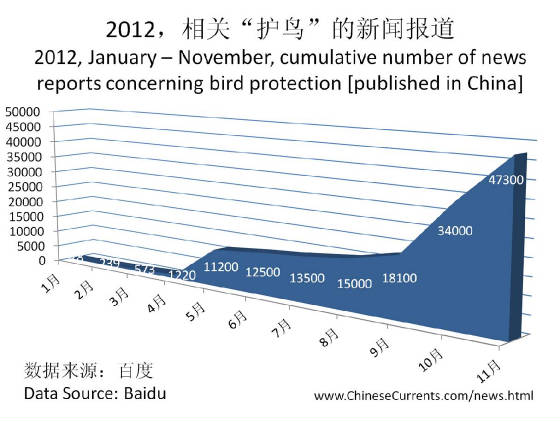 News in English from the Chinese
news agencies: PLEASE voice your support for the
volunteers who saved the lives of so many Oriental White Strorks and, in so doing, are inspiring a generation.
. Suspected poisoning - separate incident Friday, 23rd November,
2012 On Wednesday, shortly after the successful
release of the 15 Oriental White Storks that had been nursed back to health, another two storks were found to be
in difficulty, more than 100 miles along the coast. Sadly, one later died. The translated report from today's
edition of the Jinghua Times has the details. Although describing how the volunteer rescue teams rushed
from Tianjin and Beijing to help, it doesn't mention that Nemo was, again, leading the charge. Translated from
the report in the Jinghua Times, 23rd November 2012. Tangshan, Leting – Suspected poisoning of Oriental White Storks Photo caption: Dead
birds – police collect evidence (photo by this newspaper’s reporter, Tan Qing) [Report by] This newspaper’s senior reporter, Li Xianfeng. On the afternoon of the 21st, in the wetland of Leting [also locally known as Laoting] county, Tangshan, Hebei province,
Tian
Zhiwei, a local volunteer, discovered a dead Oriental White Stork, which was suspected to have been poisoned. Following on from the incident
in Beidagang, Tianjin, this is the second such case involving Oriental White Storks, a national-level “grade 1”
protected species. Leting county forestry and public security bureaus have already launched an investigation. Bird lover
discovers a dead white stork In Leting county, 44 year-old Tian Zhiwei is a famous bird-lover.
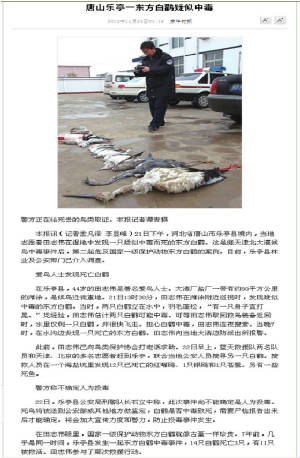 Daqing salt works includes an area of approximately 90 square kilometres
of mudflats – an important area for migrating birds. Daqing salt works includes an area of approximately 90 square kilometres
of mudflats – an important area for migrating birds.
At 1.30pm [on the 21st] Tian Zhiwei was inspecting
this vicinity when he discovered [two] Oriental White Storks that he suspected had been poisoned. [He observed] two storks with “fluffy feathers”; one of which was swaying from side to side.
Relying on his experience, Tian Zhiwei deduced that both Oriental White Storks had probably been poisoned.
When Tian Zhiwei returned
from getting the equipment [waders] needed to rescue the storks, only one stork remained in the water. It
then quickly flew off. Worried that the storks had been poisoned, Tian Zhiwei scoured the area, [and continued]
even when it became dark. Then, at 7pm that evening, he found one of the storks dead at the side of a ditch. Tian Zhiwei went
to the local Daqing police station check-point to sound the alarm. Before this, he had already phoned the bird protection society to ask for
assistance. On the morning of the 22nd, three members of the Tianjin Blue Sky
rescue team, and many volunteers from Beijing rushed to Leting, where they worked with the staff of the local public security
bureau to search for the other white stork. The search and rescue team discovered a dozen dead Black-headed Gulls, a single larger gull, and a Grey Heron
at one of the sea-salt pits; as well as some dead fish. The police say that it is not [yet] confirmed that poisoning was the cause. On the 22nd, Shi
Lizhong, the captain of Leting county police department, said that they were still assessing the evidence and that, at this
time, it was not certain that poisoning was the cause. And that the dead birds will be sent to the public security and
other bureaus for examination to determine whether or not poisoning was the cause of death. [Mr Shi went on to say that] Only when the autopsy report is published will it be known for certain.
The increased publicity
and strengthened police effort resulting from this case will protect against the reoccurrence of poisoning incidents. In the eyes of Tian Zhiwei, the national-level “grade 1” protected Oriental White Stork is just like a precious
treasure. Seven years ago, in one incident [also] in Leting county,
at just about the same time of year, 14 Oriental White Storks were found poisoned. Of these, 3 died and
11 were saved. Tian Zhiwei was involved in that rescue mission also.
. All rescued
storks "Take off smoothly". Wednesday, 21st November, 2012 At 10.25am local time today
(2.25am GMT), 15 rescued storks took to the sky. Nemo (one of the on-site volunteers),
tweeted that they "..Shunli qifei. [...Took off smoothly]" The
13 Oriental White Storks that had been nursed back to health after being poisoned were joined by 2 storks that had
been in the rescue centre since the spring migration. All the birds are colour-ringed
and three are also carrying satellite transmitters. Click HERE to see photos of the release. Other
reports covering the release that include photos: 21 Nov Xinhua
via China Daily Poisoned rare storks trigger calls for animal protection 21 Nov Shanghai Daily Poisoned Oriental White Storks released in Tianjin Reports [prior to the birds' release] in English from the Chinese news agencies: 21 Nov Xinhua
Poisoned rare storks trigger calls for intensified animal protection 21 Nov Shanghai Daily Tianjin offers 50,000 yuan to nab bird poachers 20 Nov Sina English Tianjin posts 50,000 yuan reward for bird poachers 20 Nov China Daily, by Zheng Jinran, Reward offered for information on birds' poisoning 20 Nov Global Times, written by Wang Yiqian Non-commercial conservation 19 Nov Xinhua 20 rare birds dead, 13 poisoned in tainted wetlands 17 Nov Sina English More endangered storks found dead 15 Nov China Daily, Opinion piece, Wild birds must be protected 15 Nov People's Daily (and Global Times) Storks’ plight raises larger concerns 14 Nov Shanghai Daiy: Rare storks poisoned to death by poachers 13 Nov People's Daiy (From Gobal Tines): Bird lover rushes to rescue poisoned storks 13 Nov China Daiy: Zhengjin Ran reports:
13 rare birds killed by poison
. Ready
to fly Tuesday,
20th November, 2012 - The plan is to release all of the 13 Oriental White Storks back into
the wild tomorrow.
- All of the storks will be colour ringed (and will
also have a metal ring fitted).
- The two strongest storks will additionally be fitted with a satellite
transmitter.
- The storks will be closely monitored on their flight path to their winter
quarters.
- The Beidagang management committee has offered a reward of 50,000 yuan (GBP 5,000) for information
leading to the arrest of those resonsible for killing 22 Oriental White Storks.
- Those
found guilty will receive a minimum prison term of 10 years, and also have their assets seized.
- Ms Liu, from the Natural University, has written a 10-point open letter urging the reclassification
of Beidagang Wetland, from a city-level to a national-level protected area.
- Other recommendations in her letter include
the setting up of watch towers and an on-site rescue centre.
- The wetland has been flushed by a large volume
of water in an effort to dilute any remaining toxin. Water continues to be tested at regular intervals.
- There has
been no further report of any bird or animal found poisoned [since those found dead on Saturday].
- Volunteers
and staff continue to patrol the area; and will continue to do so throughout the migration period.
. Fingers
crossed Sunday,
18th November, 2012 The report from yesterday suggests that the situation has stabalised:
Here
are the main points: - The death toll of Oriental White Storks remains
at 22.
- Around 100 storks were on the fish pond area, none of of the birds showed
any sign of sickness or abnormal behaviour.
- 13 storks remain in the rescue centre and continue to do well
- They will
be released into the wild, next Wednesday at the soonest.
- 20 more dead birds was recovered today,
mainly ducks with 1 gull.
- The police have confirmed that the toxin used in the lure pools was Carbofuran.
- No poacher has yet been caught, the investigation is continuing.
- The
Blue Sky Volunteer Rescue Team helped to recover dead birds and render the lure pools harmless.
If you haven't
done so already, please leave a message of support for the wonderful work of the many volunteers there.
Thanks!!
. Cause
for cautious optimism News from Friday, 16th November, 2012
Yesterday, just before dark, a flock of 80 Oriental White Storks landed at Beidagang (to join the three that
had been found there earlier in the day; seemingly in good health). Usually a welcome sight anywhere along the Hebei
coast, their arrival caused consternation among the dozens of volunteers who had worked hard during the day to locate more
"lure pools" (the small pools dug by poachers to attract their prey). After
hearing the report of the arrival of the large group of storks a few minutes earlier, one of the volunteers was
moved to tweet, "80 more Oriental Storks have arrived. It's a happy thing and yet it's [extremely] worrisome!!
Quickly leave Beidagang and go to find a safe place!"
 The vast majority of the flock may have heard his lament because, despite an extensive
search of the wetland today, only 8 storks could be found. But visibility was poor throughout the day, so it is possible
that more remain. The vast majority of the flock may have heard his lament because, despite an extensive
search of the wetland today, only 8 storks could be found. But visibility was poor throughout the day, so it is possible
that more remain.
The 13 storks in care continue to do well. They will
be ringed before release, and some may also be fitted with satellite transmitters. Special thanks must go to Ms
Zhang, from the Beijing Raptor Rescue Centre, who rushed to Tianjin as soon as the news of the incident broke. It
is thought that her prompt response, and devotion to caring for the storks since Sunday, saved the storks' lives.
Other good news is that the number of bodies recovered fell dramatically from
sixty birds yesterday to four birds today (one Spot-billed Duck, two duck sp. and 1 Grey Heron). Also,
none of the birds seen today showed any sign of sickness or abnormal behaviour. However,
this is an extremely large wetland. The reservoir itself has a circumference of 53.6 km, according to the 2009 Important
Bird Area (IBA) assessment by BirdLife International [here]. The IBA also includes "seasonal marshes and
cultivated land near the reservoir".
Dozens
of volunteers have been scouring the area to find the lure pools. Three more were found yesterday but, considering
the size of the wetland, there must be a strong possibility that there are some that have
yet to be found, hidden away in the reed beds and hard-to-access lagoons.
Thankfully, even more help is on its way. A 16-member Blue Sky Volunteer Rescue Team (BSVRT)
is on its way there tomorrow to replace the BSVRT team that has been working around the clock there [the BSVRT logo appears
above]. They will take with them 5 boats with outboard motors, and coordinate their effort with the people and
organisations already on the ground there to ensure that they are deployed to maximum effect. Today there were 8 Oriental White Storks, 400 swans (Whooper and Tundra Swans), and more than
4,000 other water birds in the area. There's also the possibilty that more storks, swans, and geese will
drop in tomorrow or in the next few days. Thank goodness, then, for the devoted volunteers.
A link to a 6 minute TV news report covering yesterday's events is here (in Chinese, but mainly video footage) If you haven't
done so already, please leave a message of support for the wonderful work of the many volunteers there.
Thanks!! There is an article here about Nemo and people like him that was written before the poisoning incident.
It is about the inspiration that these local heroes provide to a generation of young people in China; and it is also about
how this will shape the future of bird protection in the country. It is a story about hope. Volunteers, reserve workers, and officials will spend yet another night at the site
tonight. Respect!
. The
next 24 hours will be critical Thursday, 10
pm (GMT +8), 1 5th November 2012 5th November 2012
Dozens of volunteers spent the day scouring the
extensive wetland of Beidagang looking for more deadly "lure pools" and birds in distress. It was a day of
sadness, but also a day that people will look back on as the day that many birds' lives were saved... because 3 more lure pools were discovered, hidden away in difficult-to-access areas of the marsh and reed beds.
According to one report, at least one of
the pools contained a number of prawns; some of which have been sent away for analysis. The test results
will either confirm or refute the reporter's hypothesis that they had been laced with poison and placed there as bait.
If this were proven, it would be a strong indication that the poachers were indeed targeting the storks. One of the
13 storks in care was very poorly last night. It suffered multiple cardiac arrests, and was nursed through the
night by a volunteer who administered life saving drugs every half hour. This is the moving message that the carer sent
to this site that recounts his harrowing experience: "A suspenseful night... 1 bird had
4 cardiac arrests. I had to give it an injection of Atropine every half-hour [to counteract the effects of the poison].
Luckily it came back each time. Then, at around 4 AM it could at last hold its head up. Thank goodness!" The sad news,
however, is that many more birds were found dead during the day, including one more Oriental White Stork. This takes
the death toll to 22 birds. The bodies of 60 birds of 12 other species, including a Whooper Swan,
the first swan to fall victim to poison, and a bean goose were also found dead. Of great concern to everyone who is following
these events, is the report that was posted on Sina Weibo (the most popular Twitter-like Chinese microblogging site) just
before dark. The tweet reported that 80 Oriental White Storks had just been seen to land in the area. Clearly,
tomorrow is going to be another very hard day for the many volunteers there. Despite near-exhaustion, Nemo sent
a message to all of the people around the world who have shown such kindness by offering words of comfort to all the
volunteers at this difficult time. Nemo asked me to tell you how much everyone there appreciates your wonderful support.
He hopes that, in future, the volunteer force in China can work together with similar-minded people everywhere to make the
world a better place for birds. A link to a 6 minute local TV report covering
today's events is here (in Chinese, but mainly video footage) If you haven't
done so already, please leave a message of support for the wonderful work of the local volunteers. Thanks!! There
is an article here about Nemo and people like him that was written before the poisoning incident.
It is about the inspiration that these local heroes provide to a generation of young people in China; and it is also about
how this will shape the future of bird protection in the country. It is a story about hope. Nemo, fellow volunteers and reserve workers will spend yet another night at the site tonight. Respect!
Volunteers
find "lure pools". Death toll rises to 21. 10.45 AM 14th November UPDATE: Report from a local volunteer
 Photo source: http://weibo.com/toask Photo source: http://weibo.com/toask
The heart-breaking news is that 6 more dead Oriental White Storks were found yesterday afternoon.
This increases the death toll to 21 storks. As awful as this news is, it could have been much, much worse... That's because the team of volunteers scouring the area also found 3 evidently man-made small “lure pools".
At this stage, it is not clear whether the poachers used poison-laced fish as bait, or whether the poison was
put directy into the pools. One thing is for sure, the poachers responsible for the massacre of 16 Oriental
White Storks in Jiin province in 2001, using similar methods, were subsequently each sentenced to 12 years in prison. The discarded empty bags next to the pools were clearly marked Carbofuran. This is the chemical
that is suspected to have been used in all of the poisoning cases here. The police
are examining these bags carefully, and tissue has been taken from all of the dead birds for forenvsic testing.
Only after the toxicology analysis is completed and the report published will it be known for sure
whether Carbofuran is the only agent responsible for the deaths.  The volunteer team (mostly from the local community and nearby Tianjin city) should be applauded for their extremely hard
work. Among them, a team of cycling-enthusiasts patrolled the dam and the extensive surrounding wetland.
At least 3 of this team repeatedly waded into the marsh to search for stricken birds and hidden "lure
pools". The volunteer team (mostly from the local community and nearby Tianjin city) should be applauded for their extremely hard
work. Among them, a team of cycling-enthusiasts patrolled the dam and the extensive surrounding wetland.
At least 3 of this team repeatedly waded into the marsh to search for stricken birds and hidden "lure
pools".
Several
local bird photographers have provided financial support to cover the cost of the volunteers' accommodation and food, etc. People from a government agency also contributed to the effort. Today, even a team of firemen was called to the spot,
due to lack of proper equipment (e.g. waders and boats) to help the search and rescue operation. A round-the-clock patrol was launched last night [to continue looking for sick birds], thanks to a local
businessman’s donation of night-vision goggles. Today, the
team will focus on trying to locate more of the deadly “lure pools”, to render them harmless. Also,
safe food (mainly of small fish) will be left-out for the storks that continue to stay in the area’s wetland. Special
thanks to Nemo for the information contained within this report. On
behalf of him, thanks again for everyone's concern! If you haven't done so already, please leave a message of support for
the wonderful work of the local volunteers. Thanks!! There is an article here about Nemo and people like him that was written before the poisoning incident.
It is about the inspiration that these local heroes provide to a generation of young people in China; and it is also about
how this will shape the future of bird protection in the country. It is a story about hope. Nemo, fellow volunteers and reserve workers will spend yet another night at the site tonight. Respect!
13 storks
doing well, thanks to volunteer effort 12
PM 13th November, summary of bulletin from an on-site local volunteer 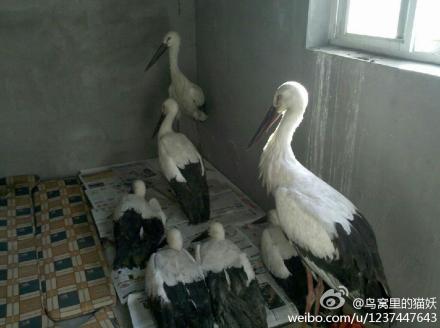
15 Oriental White Storks have been found dead so far (as at 12pm
Beijing time on 13th November) The 13 storks that were transported to the Tianjin Wildlife Rescue
Centre are recovering well (one ate 6 fish yesterday afternoon). A flock of 5 Oriental White Storks were spotted on the wetland and are being watched; the volunteers are
continuing to search a very large area for more stricken birds. 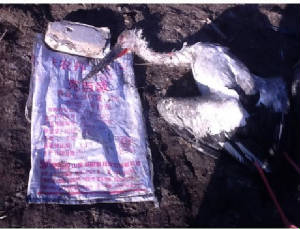 20 dead birds of other species have been found: including Mallard, Chinese Spot-billed Duck, Eurasian Teal, Gadwall,
Common Shelduck, Larus spp., Grey Heron and Eurasian Spoonbill. 20 dead birds of other species have been found: including Mallard, Chinese Spot-billed Duck, Eurasian Teal, Gadwall,
Common Shelduck, Larus spp., Grey Heron and Eurasian Spoonbill.
There could be more victims of this poisoning incident as herbivore, fish and invertebrate-eating birds
have all been affected. It is now known that
this was NOT a chemical spill, but a deliberate act of poisoning by POACHERS. It seems likely that the poachers put the toxin directly into the water. [Poachers in the area have previously targeted ducks and geese by mixing poison
in grain and wheat that is used to lure them. The stricken birds have then been captured and then sold as
food] Although the formal forensic test report
is still on its way, Carbofuran was most likely the poison that was used. This toxic chemical is a widely used
pesticide in China. It is also harmful to humans. In a previous incident in Jilin province (in 2001), the two men who killed 16 Oriental White Storks by
poisoning them were each sentenced to 12 years in prison. Many thanks to the international community for showing your support for the effort of more than 100
people who have been helping to save the birds here. Thanks for your concern! It means a lot. If you haven't done so already, please leave a message of support for the wonderful work of the local
volunteers. Thanks!!
. Local volunteers battle
to save poisoned storks 12th
November 2012, information from one of the volunteers on site 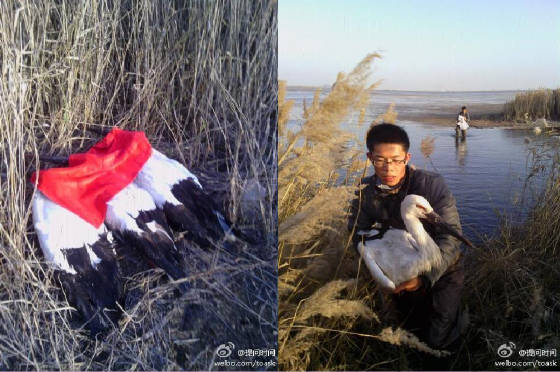
3 dead Oriental White Storks and a very sick bird being taken into care yesterday by a
local hero Photos
are from http://weibo.com/toask Latest news from
Beidagang [Received at 08:47 AM Beijing time on 12th November]: 38 Oriental White Storks have been confirmed poisoned
on the 11th (yesterday): 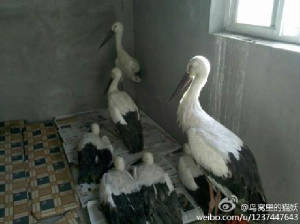 13 birds have been transported to the Tianjin Wildlife Rescue Centre and treated with an antidote. The condition of 12 birds is stable or recovering,
1 is not too promising; 13 birds have been transported to the Tianjin Wildlife Rescue Centre and treated with an antidote. The condition of 12 birds is stable or recovering,
1 is not too promising;
11 dead birds have
so far be found; 14 birds are missing from the spot, and are being looked for in the surrounding area Please leave a message of support
to the local volunteers who waded into the marsh to rescue the very sick birds and who stayed up all night last
night to nurse them. They continue to scour the area to find the missing birds.
Oriental
White Storks poisoned at Beidagang 11th
November 2012, Sina Weibo [Click here to see more photos]
Today, at 2.52pm, my wife received
a message on her Sina Weibo microblog http://weibo.com/huniao that was disturbing to say the least. This is my translation of what Rang Huniao Fei [Let Migrant Birds Fly] said
in his message: "In Tianjin, Beidagang, near to the chemical works area, [bird protection] volunteers discovered
more than 20 dead or dying Oriental White Storks – a globally endangered, national-level grade 1 protected species. Who poisoned
them?? ......" Who indeed. Watch this space for updates as the story develops. Please also have
a look at the story below, published two days ago, also from Tianjin, concerning the launch of the "law enforcement
operation" to protect the area's birds . The "local heroes" lead-story, on the main page of the
bird protection section, is also from Tianjin. Please feel free to leave a message of support to the local volunteers who waded
into the marsh to rescue the very sick birds. Some of these local heroes are staying up all night tonight
to nurse them:

|

